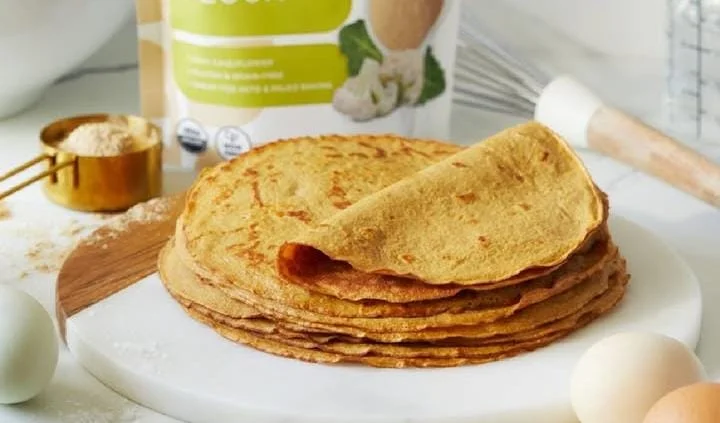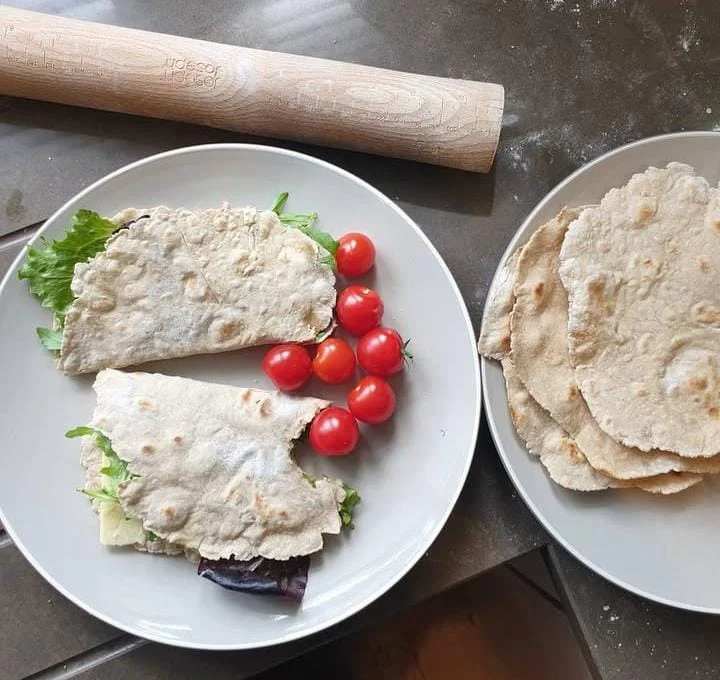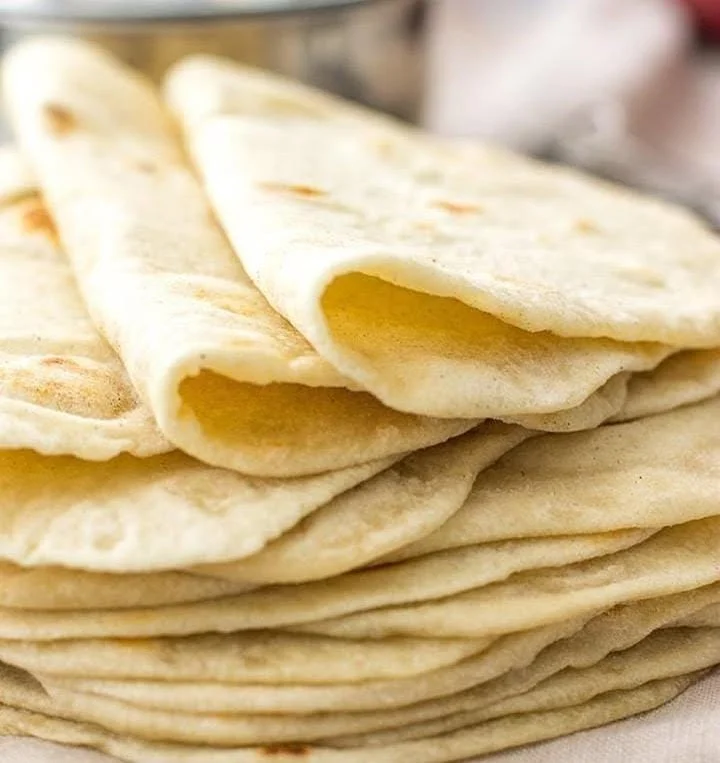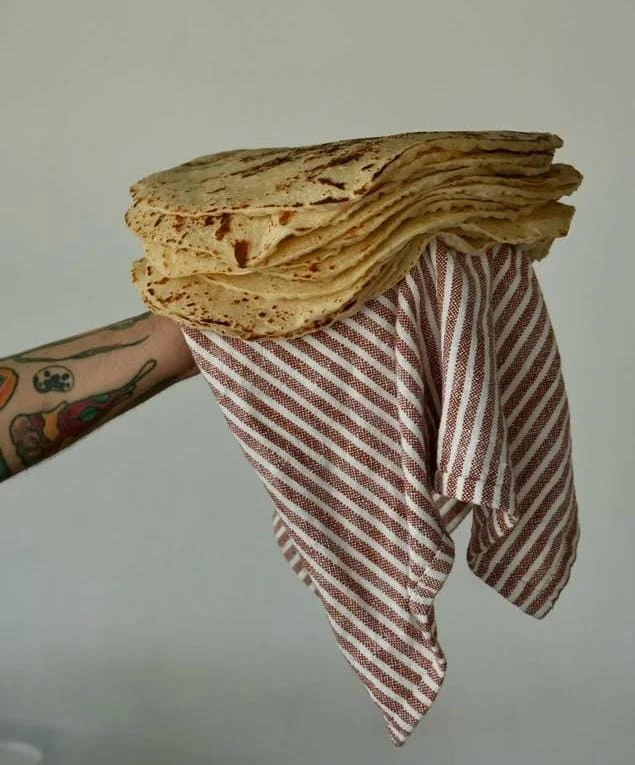Authentic Homemade Flour Tortilla Recipe | Easy, Soft, No-Yeast Tortillas Trending on Pinterest
This Homemade Flour Tortilla recipe explains in clear, practical detail how to make soft, pliable, restaurant-style tortillas at home. The recipe emphasizes simple pantry ingredients, straightforward techniques, and tips that help both beginners and experienced cooks achieve consistent results.
Across kitchens and cultures, a well-made flour tortilla elevates tacos, burritos, quesadillas, wraps, and even breakfast sandwiches. Making tortillas at home gives you control over thickness, size, and ingredients, including the option to use whole wheat or gluten-free blends.

This article covers what a flour tortilla is, the approximate nutrients per serving, a detailed list of main ingredients with exact quantities, step-by-step preparation instructions, healthy habits, and a selection of easy variations to customize the recipe for different tastes and diets. It is written to be SEO-friendly and practical so you can follow along and produce soft, warm tortillas every time.
Also try: Healthy Lunch Ideas for Work
What is a Homemade Flour Tortilla?
A homemade flour tortilla is a thin, unleavened flatbread traditionally made from wheat flour, fat, water, and salt. Unlike corn tortillas, which are made from masa harina, flour tortillas rely on the gluten in wheat to provide elasticity and structure.
Home-cooked tortillas are usually cooked on a dry skillet or comal without oil until they puff slightly and show golden brown spots. They are versatile, easy to prepare, and can be adjusted for softness, chewiness, or crispness depending on how they are rolled, rested, and cooked. Tortillas made at home often taste fresher and have a better texture than mass-produced packaged versions.

Nutrients in Homemade Flour Tortilla (Per Tortilla, Estimated)
| Component | Approximate Amount |
|---|---|
| Calories | 140–170 kcal |
| Carbohydrates | 20–22 g |
| Protein | 3–4 g |
| Fat | 4–6 g |
| Fiber | 1–2 g |
| Sodium | 150–220 mg |
| Iron | Small amount |
| Calcium | Small amount |
Main Ingredients

Below are the main ingredients with exact quantities and a full explanation of each ingredient’s role in the recipe. The recipe yields approximately twelve 8-inch tortillas, with a total finished quantity of about 24 ounces of dough, producing a little under two pounds of product when cooked and rested. Quantities are given to the level of precision that balances kitchen practicality with consistent outcomes.
All-Purpose Flour — 3 cups (360 grams)
All-purpose flour provides the structural proteins and starch that make the tortilla possible. The gluten-forming proteins in wheat, when hydrated and worked gently, give dough its elasticity and ability to stretch without tearing. Three cups of all-purpose flour, or 360 grams by weight, is a standard yield for twelve medium 8-inch tortillas. You may substitute 50 percent whole wheat for a nuttier flavor and more fiber, but whole wheat will yield a slightly denser, less stretchy tortilla.
Baking Powder — 1 teaspoon (4 grams)
Baking powder is optional but recommended in small amounts to give the dough a subtle lift and a softer texture. One teaspoon, or about 4 grams, helps create tiny air pockets that reduce toughness and make the tortilla more tender. Traditional recipes sometimes omit it for a purely unleavened flatbread, but modern home versions often use it for improved softness.
Salt — 1 teaspoon (6 grams)
Salt enhances flavor, strengthens the gluten network slightly, and balances the overall taste. One teaspoon, approximately 6 grams, seasons the dough sufficiently for a batch of twelve tortillas. Adjust only slightly to taste, remembering that salt has an important role beyond just making the dough savory.
Shortening or Lard — 1/4 cup (56 grams)
Fat is essential for tenderness and pliability. Using 1/4 cup of vegetable shortening or lard, totaling 56 grams, coats flour proteins and shortens gluten strands, which prevents toughness and yields pliable tortillas. Butter can be used for flavor, and vegetable oil is an acceptable neutral substitute, but lard or shortening produces the most traditional texture.
Warm Water — 1 cup plus 2 tablespoons (270–285 ml)
Warm water hydrates the flour to form a dough and helps fats integrate smoothly. Using approximately 1 cup and 2 tablespoons of warm water, between 270 and 285 milliliters, provides the right hydration for average humidity conditions. You may need to adjust slightly depending on your flour brand and the ambient humidity; the dough should be soft, slightly tacky, and not overly sticky.
Optional: Olive Oil — 1 tablespoon (14 grams)
Adding 1 tablespoon of olive oil increases flavor and improves dough elasticity. This is optional but recommended if you prefer a lighter mouthfeel and subtle complexity in flavor. When used in conjunction with shortening or in place of it, adjust the amount of water slightly.
Optional: Honey or Sugar — 1 teaspoon (7 grams)
A small teaspoon of honey or sugar, about 7 grams, can enhance browning and add a hint of sweetness that complements fillings. This ingredient is entirely optional; it improves color and flavor but is not necessary for authentic tortillas.
Total Quantity of the Recipe
When all ingredients are combined and after resting, the dough weighs approximately 720 to 750 grams, which yields twelve 8-inch tortillas. The finished cooked tortillas will total around 20 to 24 ounces of edible product, depending on hydration and cooking losses. This quantity is ideal for serving four to six people as part of a meal, depending on appetite and sides.
How to Prepare Homemade Flour Tortillas

The preparation is divided into clear stages: combining dry ingredients, cutting in the fat, hydrating into a dough, resting, dividing and rolling, and finally cooking. Each step affects texture, flavor, and pliability, so follow the directions carefully while allowing modest adjustments based on your kitchen conditions.
Combine Dry Ingredients
In a large mixing bowl, whisk together the three cups (360 grams) of all-purpose flour, the one teaspoon (4 grams) of baking powder, and the one teaspoon (6 grams) of salt. Whisking evenly distributes the leavening agent and salt so that every tortilla develops evenly during resting and cooking.
Make a shallow well in the center of the dry mix to receive the fat and water, which encourages even incorporation and prevents clumping. Proper distribution of dry ingredients at the start simplifies later kneading and reduces the chance of pockets of unseasoned flour. Even small bowls of measured ingredients help maintain a consistent texture across all twelve tortillas.
Cut in the Fat
Add the quarter-cup (56 grams) of shortening or lard to the well in the flour. Using a pastry cutter, two knives, or your fingertips, work the fat into the flour until the mixture resembles coarse crumbs with some pea-sized fat pockets.
This step is essential because the fat coats flour proteins, limiting gluten development and producing tender tortillas. If you are using butter or oil instead, blend until the mixture is uniformly crumbly but still slightly shaggy. The texture of the dough after adding fat should hold its shape when squeezed without feeling oily or greasy.
Hydrate and Form Dough
Pour the warm water, about one cup plus two tablespoons (270–285 ml), into the flour and fat mixture gradually while stirring with a wooden spoon or your hand. If using honey or olive oil, add them now. Mix until a rough, shaggy dough forms.
Transfer the dough to a lightly floured surface and knead for approximately two to three minutes until the dough becomes smooth, slightly tacky, and elastic. Avoid over-kneading, which would develop too much gluten and produce tougher tortillas. The goal is a cohesive dough that yields when pressed but springs back slightly.
Rest the Dough
Place the kneaded dough in a lightly oiled bowl and cover with plastic wrap or a damp towel. Rest the dough at room temperature for at least 30 minutes and up to 1 hour. Resting relaxes the gluten, making the dough easier to roll out without springing back. This also allows the water to fully hydrate the flour, improving texture and flavor. Do not skip resting; it is a small time investment with a big payoff in softness and rollability.
Divide and Shape
After resting, turn the dough onto a clean work surface and divide it into twelve equal portions, about 60 grams each. Roll each portion into a tight ball, then flatten slightly with your palm. Keep the dough balls covered with a cloth while you work through them to prevent drying.
When ready to roll, press each ball gently and begin rolling from the center outward to form thin, even circles. Aim for an 8-inch diameter for each tortilla, though you can make them smaller or larger to suit your needs.
Roll the Tortillas
Use a rolling pin to roll each dough ball into a thin circle, rotating the dough and flipping it occasionally to maintain even thickness. Sprinkle only a small amount of flour as needed to prevent sticking, being careful not to use excess flour which can make tortillas dry and tough. The ideal thickness is about 1 to 2 millimeters; very thin tortillas will crisp faster while slightly thicker ones stay pliable and are better for wraps. Consistent thickness ensures even cooking and similar final texture across the batch.
Cook on a Hot Skillet
Preheat a heavy skillet or cast-iron griddle to medium-high heat. The skillet must be hot before the tortillas are added to achieve the characteristic puff and golden spots. Place a rolled tortilla on the dry skillet and cook for about 30 to 45 seconds until you see bubbles and the underside develops brown spots. Flip and cook the other side for another 20 to 30 seconds. If the tortilla puffs, press gently with a spatula to encourage even cooking. Avoid overcrowding the pan to maintain consistent heat and allow each tortilla enough direct contact with the skillet.
Keep Warm and Store
Stack cooked tortillas and wrap them in a clean kitchen towel to keep them warm and moist until serving. For longer storage, place cooled tortillas in an airtight container or heavy-duty freezer bag and refrigerate for up to 3 days or freeze for up to 3 months. Reheat on a hot skillet for a few seconds on each side or wrap in a damp paper towel and microwave briefly to regain pliability. Proper storage maintains softness and prevents drying out.

Healthy Habits
Incorporating homemade flour tortillas into a balanced diet is straightforward when you follow healthy habits that consider portion sizes, ingredient choices, and meal composition. Opting to replace a portion of all-purpose flour with whole wheat can increase fiber and nutrients. Using moderate amounts of healthy fats, like olive oil in place of lard, reduces saturated fat content.
Pair tortillas with lean proteins, beans, and a generous serving of vegetables to construct a balanced meal that provides sustained energy and micronutrients. Moderation is key: enjoy these warm, homemade tortillas frequently but in sensible portions, and complement them with nutrient-dense sides.
Variations of Homemade Flour Tortillas

Whole Wheat Tortillas
Whole wheat tortillas replace half or all of the all-purpose flour with whole wheat flour for more fiber and a nutty flavor.
Start by substituting 1.5 cups of whole wheat flour and 1.5 cups of all-purpose flour, then proceed with the standard method.
The dough will be slightly denser and may require a touch more warm water to reach the same pliable consistency.
Resting remains essential because whole wheat benefits from hydration to soften bran and improve rollability.
These tortillas pair excellently with hearty fillings like grilled vegetables, black beans, or roasted chicken.
To enhance tenderness when using more whole wheat, add an extra tablespoon of olive oil or a little more shortening.
Rolling should be done gently to prevent tearing, and rolling pins with a slightly textured surface can help control thickness.
Cook on a hot skillet as usual, watching carefully because whole wheat tortillas may brown faster.
Store them wrapped in a towel to retain moisture, and reheat briefly before serving to restore suppleness.
Whole wheat tortillas are a wholesome option that boosts fiber without sacrificing the comforting taste of homemade flatbread.

Garlic Herb Tortillas
Garlic herb tortillas infuse the dough with savory aromatics by adding minced garlic and finely chopped fresh herbs.
Mix one to two cloves of minced garlic and one tablespoon of chopped fresh herbs such as parsley or cilantro into the dough.
Knead briefly to distribute the aromatics evenly, being careful not to overwork the dough after adding the herbs.
The garlic and herbs add a fragrant lift that complements grilled meats, hummus, or tomato-based fillings.
These flavorful tortillas work equally well for wraps, paninis, and as a base for quick flatbread pizzas.

For a milder flavor, use roasted garlic or reduce the fresh garlic to half a clove per batch.
Herb combinations like oregano and basil give an Italian twist that pairs well with cheeses and tomato sauces.
Be mindful that fresh herbs can add extra moisture; adjust the flour slightly if the dough becomes too sticky.
Cooking times remain the same, but you may notice more rapid browning due to aromatic sugars in the garlic.
Garlic herb tortillas transform simple meals with an aromatic, savory note without adding complexity to the recipe.
Cheesy Tortillas
Cheesy tortillas fold shredded cheese into the dough or sprinkle cheese on the tortilla surface during cooking for melty goodness.
Use sharp cheddar, Monterey Jack, or a Mexican cheese blend for best melting and flavor results.
Add about three quarters to one cup of finely shredded cheese evenly into the dough or place cheese on half of the rolled tortilla and fold.
The cheese melds with the dough as it cooks, creating pockets of melted richness that are irresistible in tacos and quesadillas.
Ensure even distribution so some tortillas do not become overly greasy or fail to seal properly during cooking.
If incorporating cheese into the dough, reduce the fat slightly to compensate for added oil from the cheese.
Cooking slightly longer on lower heat helps the cheese melt through without burning the tortilla surface.
Cheesy tortillas make excellent bases for breakfast wraps with eggs or for snackable grilled cheese-style tacos.
For crispier edges, press the tortilla gently while cooking to encourage the cheese to contact the skillet.
This variation is indulgent and satisfying, especially when served fresh from the pan with simple salsas or pickled vegetables.
Gluten-Free Tortillas
A gluten-free tortilla requires blending alternative flours such as rice flour, tapioca starch, and a binder like xanthan gum.
Start with a pre-made gluten-free flour blend formulated for flatbreads and follow similar hydration principles used for wheat dough.
Because gluten-free dough behaves differently, the texture will be more delicate and may require rolling between parchment sheets.
Use a mix of 2 cups gluten-free all-purpose flour and half cup tapioca starch to achieve stretch and elasticity.
Cooking on moderate heat and handling gently will help maintain structure and prevent tearing while cooking.
For extra pliability, incorporate a tablespoon of psyllium husk or 1 teaspoon of xanthan gum into the dry mix.
These binders mimic gluten’s properties and help the dough achieve the cohesion needed for rolling and folding.
Allow the dough to rest longer so the flours fully hydrate and the binders can activate properly before rolling.
Store gluten-free tortillas in parchment or plastic to retain moisture, and reheat carefully to avoid drying them out.
While texture differs from wheat tortillas, gluten-free versions provide a versatile alternative for those with sensitivities.
Serving Suggestions
Homemade flour tortillas are remarkably versatile and make a cornerstone for many meals across the day. Serve warm tortillas with grilled meats, sofritas, seasoned beans, or roasted vegetables for balanced, flavorful plates.
They also work as breakfast vessels for eggs, avocado, and cheese, or as wrappers for cold salads which benefit from the soft, slightly chewy texture. For presentation, stack tortillas on a warm plate and cover with a napkin-lined basket to keep them moist during service. Leftover tortillas can be transformed into chips by cutting and baking until crisp; toss with a little oil and salt for a quick snack.
Conclusion
Mastering homemade flour tortillas provides a flexible foundation for countless meals and culinary experiments. With a reliable ratio of flour, fat, water, and salt, you can produce soft, warm tortillas that rival restaurant versions while tailoring ingredients to dietary needs.
Key techniques—cutting fat into flour, moderate kneading, sufficient resting, and cooking on a hot skillet—are responsible for consistent success. Experiment with thickness, size, and variations such as whole wheat, garlic herb, cheesy, or gluten-free versions to expand your repertoire. When stored and reheated properly, these tortillas remain convenient, flavorful, and a wholesome addition to many meals.





